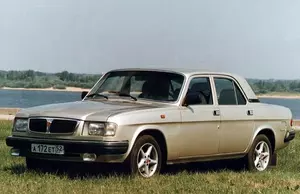
| Vehicle | Curb weight | Difference from world's smallest | Weight to power ratio | 0—60 mph acceleration ratio | Consumption ratio |
|---|---|---|---|---|---|
| 2.3 i 16V |
1450 kg / 3197 lbs |
1025 kg (2260 lbs) heavier | 11 kg to 1 hp | 113 kg/s (249 lbs/s) | - |
| 2.3 16V |
1500 kg / 3308 lbs |
1075 kg (2371 lbs) heavier | 10 kg to 1 hp | 117 kg/s (258 lbs/s) | - |
| 2.5 |
1450 kg / 3197 lbs |
1025 kg (2260 lbs) heavier | 16 kg to 1 hp | 80 kg/s (176 lbs/s) |
156 kg/L (344 lbs/L) |
| 2.4 |
1540 kg / 3396 lbs |
1115 kg (2459 lbs) heavier | 19 kg to 1 hp | 74 kg/s (163 lbs/s) | - |
| Vehicle | 2.3 i 16V |
|---|---|
| Curb weight |
1450 kg / 3197 lbs |
| Difference from world's smallest | 1025 kg (1025 lbs) heavier |
| Weight to power ratio | 11 kg to 1 hp |
| 0—60 mph acceleration ratio | 113 kg/s (249 lbs/s) |
| Consumption ratio | - |
| Vehicle | 2.3 16V |
| Curb weight |
1500 kg / 3308 lbs |
| Difference from world's smallest | 1075 kg (1075 lbs) heavier |
| Weight to power ratio | 10 kg to 1 hp |
| 0—60 mph acceleration ratio | 117 kg/s (258 lbs/s) |
| Consumption ratio | - |
| Vehicle | 2.5 |
| Curb weight |
1450 kg / 3197 lbs |
| Difference from world's smallest | 1025 kg (1025 lbs) heavier |
| Weight to power ratio | 16 kg to 1 hp |
| 0—60 mph acceleration ratio | 80 kg/s (176 lbs/s) |
| Consumption ratio |
156 kg/L (344 lbs/L) |
| Vehicle | 2.4 |
| Curb weight |
1540 kg / 3396 lbs |
| Difference from world's smallest | 1115 kg (1115 lbs) heavier |
| Weight to power ratio | 19 kg to 1 hp |
| 0—60 mph acceleration ratio | 74 kg/s (163 lbs/s) |
| Consumption ratio | - |

| Vehicle | Curb weight | Difference from world's smallest | Weight to power ratio | 0—60 mph acceleration ratio | Consumption ratio |
|---|---|---|---|---|---|
| 2.3 i 16V |
1690 kg / 3726 lbs |
1265 kg (2789 lbs) heavier | 13 kg to 1 hp | 131 kg/s (289 lbs/s) | - |
| 2.3 |
1550 kg / 3418 lbs |
1125 kg (2481 lbs) heavier | 11 kg to 1 hp | 121 kg/s (267 lbs/s) | - |
| 2.1 TD |
1550 kg / 3418 lbs |
1125 kg (2481 lbs) heavier | 14 kg to 1 hp | 107 kg/s (236 lbs/s) | - |
| 2.5 i |
1550 kg / 3418 lbs |
1125 kg (2481 lbs) heavier | 10 kg to 1 hp | 126 kg/s (278 lbs/s) | - |
| Vehicle | 2.3 i 16V |
|---|---|
| Curb weight |
1690 kg / 3726 lbs |
| Difference from world's smallest | 1265 kg (1265 lbs) heavier |
| Weight to power ratio | 13 kg to 1 hp |
| 0—60 mph acceleration ratio | 131 kg/s (289 lbs/s) |
| Consumption ratio | - |
| Vehicle | 2.3 |
| Curb weight |
1550 kg / 3418 lbs |
| Difference from world's smallest | 1125 kg (1125 lbs) heavier |
| Weight to power ratio | 11 kg to 1 hp |
| 0—60 mph acceleration ratio | 121 kg/s (267 lbs/s) |
| Consumption ratio | - |
| Vehicle | 2.1 TD |
| Curb weight |
1550 kg / 3418 lbs |
| Difference from world's smallest | 1125 kg (1125 lbs) heavier |
| Weight to power ratio | 14 kg to 1 hp |
| 0—60 mph acceleration ratio | 107 kg/s (236 lbs/s) |
| Consumption ratio | - |
| Vehicle | 2.5 i |
| Curb weight |
1550 kg / 3418 lbs |
| Difference from world's smallest | 1125 kg (1125 lbs) heavier |
| Weight to power ratio | 10 kg to 1 hp |
| 0—60 mph acceleration ratio | 126 kg/s (278 lbs/s) |
| Consumption ratio | - |

| Vehicle | Curb weight | Difference from world's smallest | Weight to power ratio | 0—60 mph acceleration ratio | Consumption ratio |
|---|---|---|---|---|---|
| 2.1 TD |
1560 kg / 3440 lbs |
1135 kg (2503 lbs) heavier | 16 kg to 1 hp | 108 kg/s (238 lbs/s) | - |
| 2.3 |
1400 kg / 3087 lbs |
975 kg (2150 lbs) heavier | 9 kg to 1 hp | 109 kg/s (240 lbs/s) | - |
| 2.3 i 16V |
1400 kg / 3087 lbs |
975 kg (2150 lbs) heavier | 11 kg to 1 hp | 109 kg/s (240 lbs/s) | - |
| 2.5 |
1401 kg / 3089 lbs |
976 kg (2152 lbs) heavier | 16 kg to 1 hp | 64 kg/s (141 lbs/s) | - |
| Vehicle | 2.1 TD |
|---|---|
| Curb weight |
1560 kg / 3440 lbs |
| Difference from world's smallest | 1135 kg (1135 lbs) heavier |
| Weight to power ratio | 16 kg to 1 hp |
| 0—60 mph acceleration ratio | 108 kg/s (238 lbs/s) |
| Consumption ratio | - |
| Vehicle | 2.3 |
| Curb weight |
1400 kg / 3087 lbs |
| Difference from world's smallest | 975 kg (975 lbs) heavier |
| Weight to power ratio | 9 kg to 1 hp |
| 0—60 mph acceleration ratio | 109 kg/s (240 lbs/s) |
| Consumption ratio | - |
| Vehicle | 2.3 i 16V |
| Curb weight |
1400 kg / 3087 lbs |
| Difference from world's smallest | 975 kg (975 lbs) heavier |
| Weight to power ratio | 11 kg to 1 hp |
| 0—60 mph acceleration ratio | 109 kg/s (240 lbs/s) |
| Consumption ratio | - |
| Vehicle | 2.5 |
| Curb weight |
1401 kg / 3089 lbs |
| Difference from world's smallest | 976 kg (976 lbs) heavier |
| Weight to power ratio | 16 kg to 1 hp |
| 0—60 mph acceleration ratio | 64 kg/s (141 lbs/s) |
| Consumption ratio | - |

| Vehicle | Curb weight | Difference from world's smallest | Weight to power ratio | 0—60 mph acceleration ratio | Consumption ratio |
|---|---|---|---|---|---|
| 2.1 TD |
1540 kg / 3396 lbs |
1115 kg (2459 lbs) heavier | 16 kg to 1 hp | 106 kg/s (234 lbs/s) | - |
| 2.3 i 16V |
1540 kg / 3396 lbs |
1115 kg (2459 lbs) heavier | 12 kg to 1 hp | 112 kg/s (247 lbs/s) | - |
| 2.3 16V |
1450 kg / 3197 lbs |
1025 kg (2260 lbs) heavier | 10 kg to 1 hp | 113 kg/s (249 lbs/s) | - |
| 2.5 |
1540 kg / 3396 lbs |
1115 kg (2459 lbs) heavier | 17 kg to 1 hp | 77 kg/s (170 lbs/s) |
148 kg/L (326 lbs/L) |
| 2.4 |
1540 kg / 3396 lbs |
1115 kg (2459 lbs) heavier | 19 kg to 1 hp | 68 kg/s (150 lbs/s) |
143 kg/L (315 lbs/L) |
| Vehicle | 2.1 TD |
|---|---|
| Curb weight |
1540 kg / 3396 lbs |
| Difference from world's smallest | 1115 kg (1115 lbs) heavier |
| Weight to power ratio | 16 kg to 1 hp |
| 0—60 mph acceleration ratio | 106 kg/s (234 lbs/s) |
| Consumption ratio | - |
| Vehicle | 2.3 i 16V |
| Curb weight |
1540 kg / 3396 lbs |
| Difference from world's smallest | 1115 kg (1115 lbs) heavier |
| Weight to power ratio | 12 kg to 1 hp |
| 0—60 mph acceleration ratio | 112 kg/s (247 lbs/s) |
| Consumption ratio | - |
| Vehicle | 2.3 16V |
| Curb weight |
1450 kg / 3197 lbs |
| Difference from world's smallest | 1025 kg (1025 lbs) heavier |
| Weight to power ratio | 10 kg to 1 hp |
| 0—60 mph acceleration ratio | 113 kg/s (249 lbs/s) |
| Consumption ratio | - |
| Vehicle | 2.5 |
| Curb weight |
1540 kg / 3396 lbs |
| Difference from world's smallest | 1115 kg (1115 lbs) heavier |
| Weight to power ratio | 17 kg to 1 hp |
| 0—60 mph acceleration ratio | 77 kg/s (170 lbs/s) |
| Consumption ratio |
148 kg/L (326 lbs/L) |
| Vehicle | 2.4 |
| Curb weight |
1540 kg / 3396 lbs |
| Difference from world's smallest | 1115 kg (1115 lbs) heavier |
| Weight to power ratio | 19 kg to 1 hp |
| 0—60 mph acceleration ratio | 68 kg/s (150 lbs/s) |
| Consumption ratio |
143 kg/L (315 lbs/L) |

| Vehicle | Curb weight | Difference from world's smallest | Weight to power ratio | 0—60 mph acceleration ratio | Consumption ratio |
|---|---|---|---|---|---|
| 2.4 |
1400 kg / 3087 lbs |
975 kg (2150 lbs) heavier | 14 kg to 1 hp | 77 kg/s (170 lbs/s) |
109 kg/L (240 lbs/L) |
| Vehicle | 2.4 |
|---|---|
| Curb weight |
1400 kg / 3087 lbs |
| Difference from world's smallest | 975 kg (975 lbs) heavier |
| Weight to power ratio | 14 kg to 1 hp |
| 0—60 mph acceleration ratio | 77 kg/s (170 lbs/s) |
| Consumption ratio |
109 kg/L (240 lbs/L) |